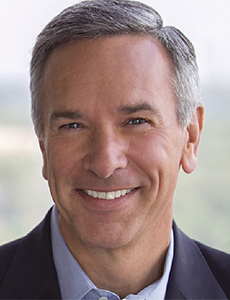The human resource profession has been around for at least a century. In recent years, the field’s leaders have dramatically advanced the function by transforming their roles into trusted business advisers, skillful change managers and consultants proficient in technology and artificial intelligence.
“Really good HR leaders have to be really exquisite in their consultative capabilities,” says Peter M. Fasolo, executive vice president and chief HR officer at Johnson & Johnson in New Brunswick, N.J. “They have to align their work, diagnose it, implement it, evaluate it, make sure it’s outcome-focused as opposed to process-focused and be very savvy from a digital and technology standpoint.”

Earlier this year, Fasolo and three of his peers were named fellows to the National Academy of Human Resources’ Class of 2017. The NAHR, which has recognized 172 individuals for exceptional achievement in the HR field over the past 25 years, also welcomed Christine Pambianchi, senior vice president of HR for Corning Inc.; Timothy Bartl, executive vice president, general counsel and secretary of the HR Policy Association and CEO of the Center on Executive Compensation; and Donna Morris, executive vice president for customer and employee experience at Adobe Systems Inc.
Like others before them, these fellows are raising the bar for required skills and competencies of HR leadership. Still, they believe HR executives can never neglect their primary role. To succeed both now and in the years ahead, they must be world-class in the game of picking and keeping winners to advance their company’s talent-management agenda.
Leadership Components
In this new era of HR, strong leaders are well-grounded in company strategy. Fasolo spends time in the company’s research lab and on the manufacturing floor. Four times a year, he devotes a full day working with a company sales representative in the pharmaceutical, medical devices or consumer side of the business. He says this makes him a better, more credible HR leader because it helps him convey the practical issues, from strategy to implementation, to C-suite executives.
So does creating his own board of directors.
Fasolo says his personal board, which functions informally, helps him keep one eye on the future and the other on company strategy and HR policies, programs and activities. His board members include the CEO, CFO and senior-level business leaders at J&J, along with external senior recruiters, consultants, academicians and CHROs at other companies.
Fasolo says HR leaders also need to be gifted in navigating conflict or being objective arbitrators of problem solving.
“The head of HR has to be agenda-less … or be a straight shooter,” he says. “You can’t advocate for one department over another. That’s the only way trust and confidence in your advice can permeate the C-suite, board, general counsel and executive team.”
Meanwhile, Fasolo predicts, the big push for artificial intelligence in the workplace will continue. While not every HR professional is comfortable with the disruption occuring in technology, expertise in this area could separate future leaders from followers.
“If we don’t get in front of this, the tsunami will come over us and companies will bypass the HR function,” Fasolo says, adding that HR leaders of the future will come from nontraditional HR roles like marketing or technology.
Consider that routine finance jobs will no longer be performed by people, but by machines, adds Bartl at the HR Policy Association.
“We’re at the precipice of automation, robotics and artificial intelligence at a time when there’s an awful lot of economic anxiety and cultural expectations of companies,” he says. “The issue is not just anticipating how to be more efficient with technology and automation, but providing for the workforce transition and some of the external cultural issues that might be developed from that.”
In a similar capacity, analytics is here to stay. HR leaders must learn how to interpret and implement data in meaningful ways to make constructive decisions, Bartl says. For example, how can data be used to structure the skills of the future, identify which disciplines make sense to work together or redevelop and redeploy employees to be more effective in their jobs?
Inevitable, Possibly Predictable
Beyond analytics, Bartl says change management represents a giant hurdle for HR leaders. Short of owning a crystal ball, they need to be experts at identifying trends and future competencies and skills, clearly communicating to employees what changes will occur and why, and then implementing them.
For example, consider the unique ways work may be performed within the next five years or how employers may modify processes to compete in a global marketplace.

Some HR leaders, Bartl says, stay up to speed on industry trends or issues by engaging C-suite members in a conversation about competitive pressures. Many act as “headlights” for the company’s board so it can make more informed decisions about compensation and succession planning.
Working with board members can be tricky, however.
“The quickest way a CHRO can damage his or her credibility is fail to develop an effective relationship with the compensation committee chair,” says Bartl. “This is a telling factor … that projects through the board.”
Adobe Systems’ Morris says change management and disruption generally go hand in hand. Whether change involves a company merger or driverless vehicles, HR leaders must retool their workforce in advance to prepare for it, adjust to it and accept it.
Front-line services are already being disrupted by technology advancements, she says, pointing to online recruiting processes or managers logging online for supervisory guidance. So much of an HR leader’s job requires leveraging new technology to drive key outcomes.
“The requirement [for HR leaders] to consult back to the business broadly around change and make the bold move to change their organization is disruptive,” Morris says. “I ask our CEO for forgiveness in terms of trying to drive change and disrupt.”

Unfortunately, not every HR leader has access to C-suite executives or reports to the CEO, which can be problematic. Under these circumstances, Morris says, HR leaders must build strong relationships with senior staff and engage with other leaders to learn the business inside and out. Otherwise, she says, HR itself will lose ground and turn into an administrative function, as opposed to a strategic enabler of company success.
Despite all of the challenges and responsibilities surrounding HR leaders, there’s one more they need to own: growing the profession.
“The way we give back as leaders is by really sharing with others the potential that this could be a fantastic career,” Morris says. “That’s our responsibility. We need to be more accessible [through] social venues like LinkedIn, Twitter.”
Meanwhile, Morris is disturbed by recent headlines about sexual harassment in the workplace. Where were the HR leaders in these organizations? Why weren’t they accessible?
“We all get enamored as leaders by doing more strategic work,” Morris says. “You earn the right to do that when your company is functioning properly.”
Prime Directive
There’s been so much emphasis on HR leaders becoming business savvy that some tend to lose sight of their major role, says Corning’s Pambianchi.
“We need to make sure we remain capable in our craft,” she says, pointing to areas such as labor laws, compensation, management assessment, and diversity and inclusion. “It’s really important to understand the business, but what you bring to the table is your HR expertise. People are losing sight of that.”
She says HR leaders must invest in themselves to maintain their currency and be capable in the areas of HR that matter to the business. For example, Pambianchi travels to Corning’s 70 plants worldwide, attends all board meetings, sits on the company’s growth execution council and oversees its innovation programs. She learns what drives the business so she can better understand what company leaders need, better serve them and deliver business results.
But supporting the enterprise, leadership and employees demands insight and diplomacy. Sometimes, she says, HR leaders must take a tough stance with senior executives who avoid addressing sensitive issues such as corporate ethics.
In the near future, Pambianchi says, more HR leaders will run their departments like a business by creating objectives and goals, and sharing them with business leaders, who then hold them accountable for their actions.
“We ask and hold ourselves to that same standard as we hold any other business function to,” she says. “Those are things that drive credibility and trust.”

Considering the advances in technology, Pambianchi says, too many HR leaders are focused on the enterprise or its leadership while first-line supervisors must fend for themselves. That leads to “major hiccups with the breakdown of values and ethics in companies,” she says, adding that HR leaders must develop strong employee relationships.
Five years from now, Pambianchi believes the outputs that HR leaders and their staff deliver aren’t going to change, but how they’re delivered will. For instance, how HR leaders communicate and perform their jobs, she says, will be impacted by new work processes, increasing labor fluidity and technology advancements, such as cloud-linked work phones that also allow workers to access personal data.
Now that HR leaders are no longer just the brokers of information or keepers of policy, she says, they need to determine what the next higher-order value contribution will be.
“Embrace it. Define it. Skill up for it. Do it,” she says.

